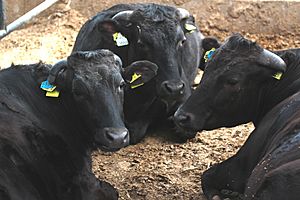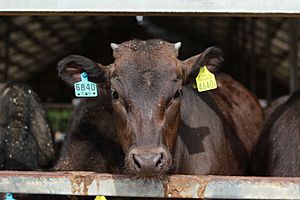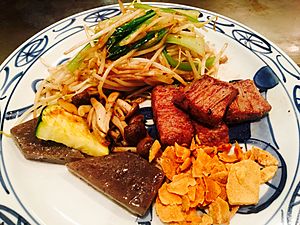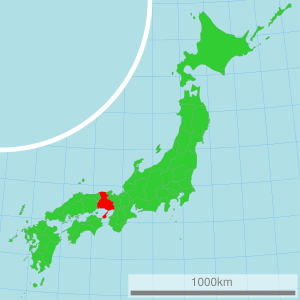Kobe beef facts for kids
Kobe beef (神戸ビーフ, Kōbe bīfu) is a very special type of Wagyu beef from Japan. It comes from a specific kind of Japanese Black cattle called Tajima, raised in a place called Hyōgo Prefecture. Farmers follow strict rules set by the Kobe Beef Marketing and Distribution Promotion Association to raise these cattle. People love Kobe beef because it's super tender, has amazing flavor, and is beautifully marbled with fat.
You can enjoy Kobe beef in many ways, like steaks, sukiyaki (a hot pot dish), shabu-shabu (another hot pot dish), sashimi (raw meat slices), or teppanyaki (grilled on a hot plate). It's considered one of the top three famous Japanese beefs, along with Matsusaka beef and Ōmi beef or Yonezawa beef.
In Japanese, Kobe beef is also called Kōbe-niku (神戸肉, "Kobe meat"), Kōbe-gyū, or Kōbe-ushi (神戸牛, "Kobe cattle").
The History of Kobe Beef


Cattle first arrived in Japan from China around the second century AD, during the Yayoi period. For a long time, until about 1868 (the Meiji Restoration), these animals were mainly used for work. They helped with farming, forestry, mining, and carrying things. They also provided fertilizer for crops.
People in Japan didn't drink Milk, and for cultural and religious reasons, they generally didn't eat meat.
Japan was mostly closed off from the rest of the world from 1635 until 1854. This meant no new types of cattle could come into the country during that time. So, the cattle population stayed the same.
After 1868, when Japan opened up, some foreign cattle were brought in. Between 1868 and 1887, about 2,600 foreign cattle arrived, including breeds like Braunvieh, Shorthorn, and Devon.
Around 1900 to 1910, these foreign cattle were extensively cross-bred with the native Japanese cattle. From 1919, the different mixed groups of cattle were officially registered. They were then carefully selected and bred to create "Improved Japanese Cattle."
By 1944, four main types of Wagyu breeds were recognized. These were based on which foreign cattle had influenced them the most. The four Wagyu breeds are the Japanese Black, the Japanese Brown, the Japanese Polled, and the Japanese Shorthorn. The Tajima cattle, which produce Kobe beef, are a special type of the Japanese Black breed. This is the most common Wagyu breed, making up about 90% of all Wagyu cattle.
Eating beef wasn't very common in Japan until after World War II. Kobe beef started to become much more popular and known around the world in the 1980s and 1990s.
In 1983, the Kobe Beef Marketing and Distribution Promotion Association was created. Their job was to set rules and promote the Kobe beef trademark. They decide which animals can be called Kobe beef.
In 2009, the USDA stopped all Japanese beef imports. This was to prevent a Japan foot-and-mouth outbreak from spreading to the US. The ban was lifted in August 2012, and after that, Kobe beef could be imported into the US again.
What Makes Kobe Beef Special?
In Japan, Kobe beef is a registered trademark of the Kobe Beef Marketing and Distribution Promotion Association (神戸肉流通推進協議会, Kōbeniku Ryūtsū Suishin Kyōgikai). This means it must meet many strict rules to be called "Kobe beef":
- The cattle must be Tajima cattle born in Hyōgo Prefecture.
- They must be raised and fed on farms in Hyōgo Prefecture.
- The animal must be a heifer (a female cow that hasn't given birth) or a bullock (a young male bull).
- The cattle must be processed at specific slaughterhouses in Hyōgo Prefecture, such as Kobe, Nishinomiya, Sanda, Kakogawa, or Himeji.
- The meat must have a very high marbling score, called BMS, of level 6 or higher. This means it has a lot of fine fat streaks.
- The meat quality score must be 4 or 5, and the yield grade must be A or B.
- The carcass (the body of the animal after processing) must weigh 499.9 kg or less.
These special cattle are fed a diet of grain fodder. Sometimes, they are even brushed to help their fur and skin. The fat in Kobe beef (from Tajima cattle) melts at a lower temperature than regular beef fat. This helps it feel extra tender and melt in your mouth.
Kobe beef is quite expensive. This is partly because only about 3,000 cattle each year qualify to be called Kobe beef. In Japan, every single cattle, including those that become Kobe beef, can be tracked. They have a 10-digit number that lets people follow them through their entire life.
Kobe Beef Around the World
For a long time, Kobe beef was not exported outside Japan. This changed in 2012. The first exports went to Macau in January 2012, and then to Hong Kong in July 2012. Since then, Kobe beef has also been sent to countries like the United States, Singapore, Switzerland, Thailand, the United Kingdom, and Canada.
In some countries, like Canada, the UK, and the US, Wagyu cattle are raised. These cattle might be purebred Wagyu imported from Japan, or they might be cross-bred with other beef types like Aberdeen Angus. Meat from these cattle is sometimes sold as "Kobe-style beef." However, this is not the same as real Kobe beef from Japan. It doesn't meet the strict rules for authentic Japanese Kobe beef. Because the Kobe beef trademark isn't always legally protected in every country, some places can even sell this "Kobe-style" meat as "Kobe beef."
The Kobe Beef Marketing and Distribution Promotion Association plans to create information booklets in different languages. This will help people around the world understand what real Kobe beef is.
American "Kobe-style" beef often looks darker and tastes stronger than the real Japanese product. This might appeal more to people in Western countries who are not used to the very mild taste and high fat content of true Kobe beef.
See also
 In Spanish: Buey de Kobe para niños
In Spanish: Buey de Kobe para niños




